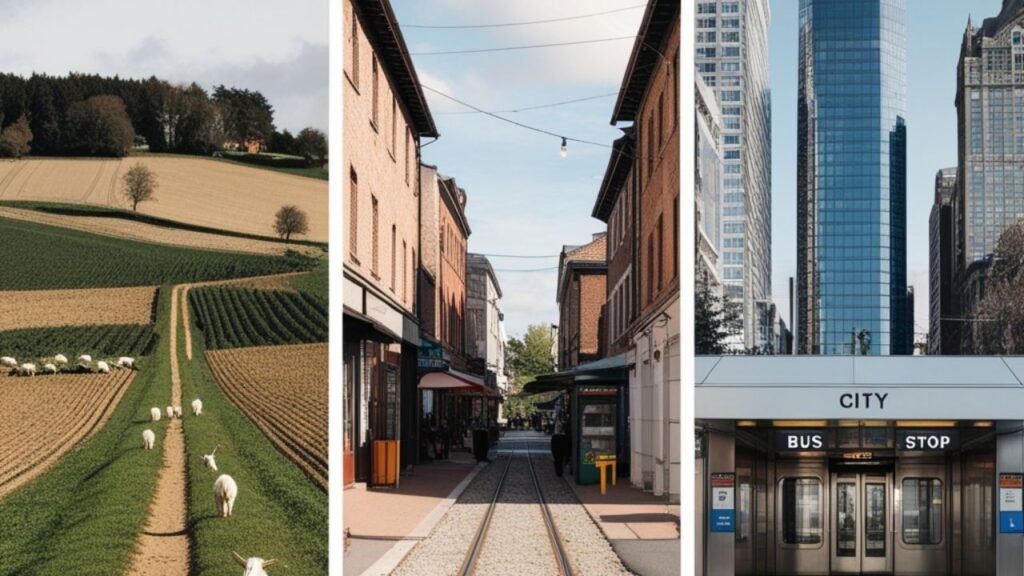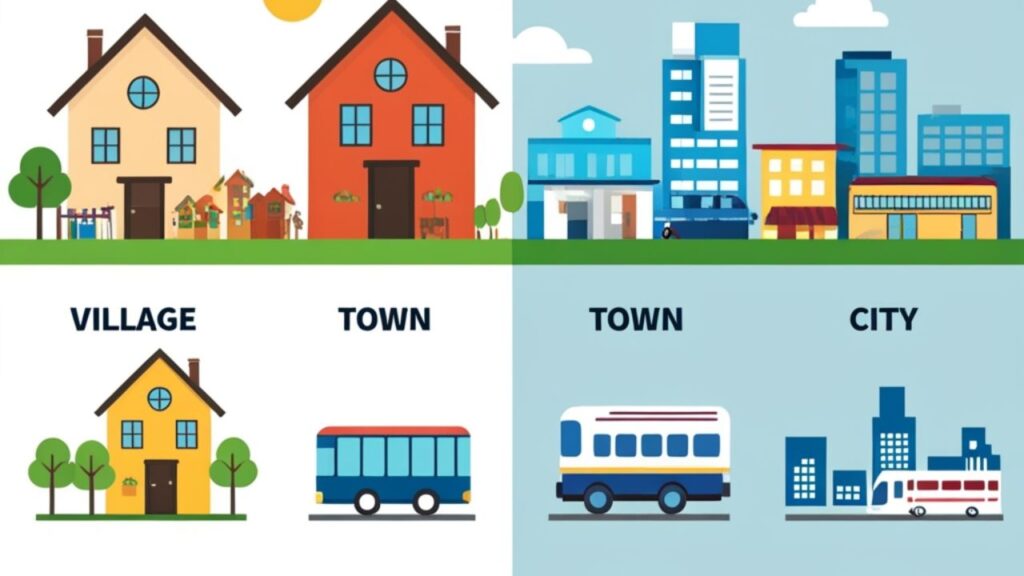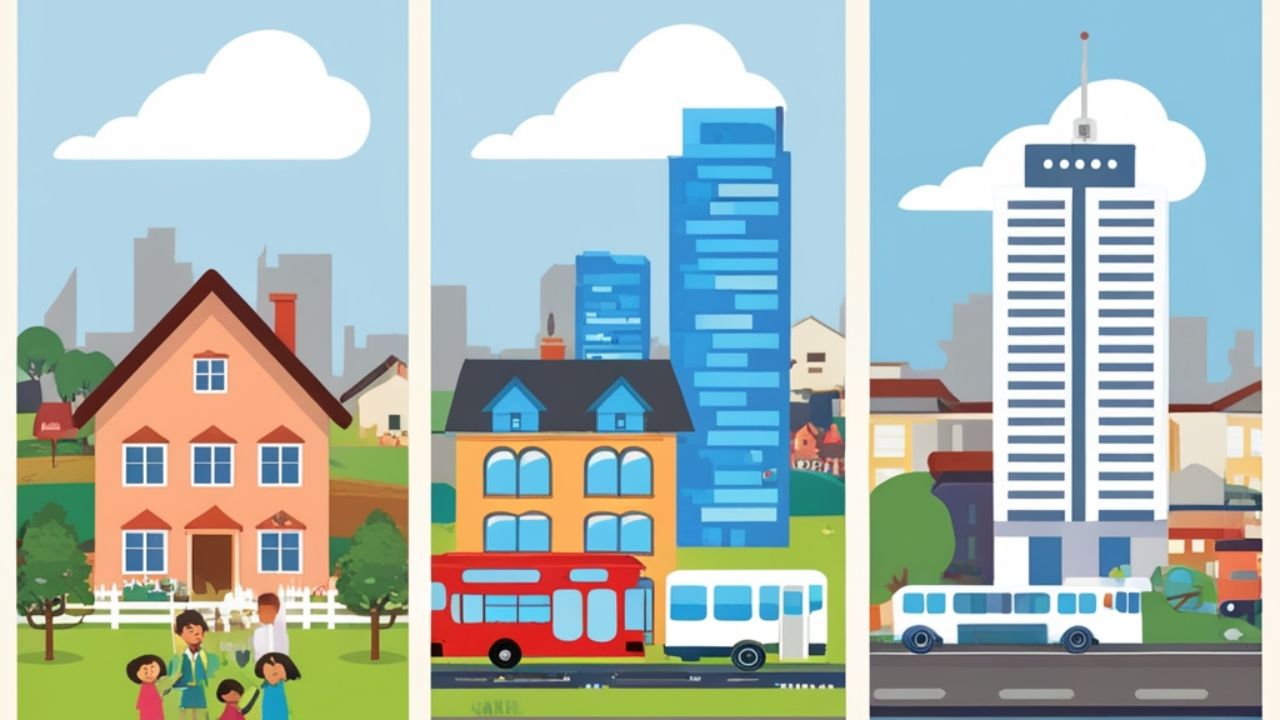A city is large and busy, with tall buildings and many homes. A town is smaller and calmer, with fewer streets and shops. A village is tiny and close-knit. People live near fields. Each place grows to match local needs.
Services change with size. In a city, you find hospitals, universities, and big transit lines. A town offers clinics, schools, and buses. A village keeps simple services like a small clinic and primary school. Local leaders guide rules, roads, and safety.
Daily life also differs. A city brings many jobs, museums, and sports. A town mixes shops with parks and fairs. A village centers on farms and family ties. People move between places for study, work, and trade, building strong regional links.
Clear Definitions: What Exactly Are Villages, Towns, and Cities?
A village is a small place where few families live close together. People farm, fish, or run tiny shops. Homes sit near fields and simple roads. Services stay basic, like a clinic and primary school. Neighbors know each other and share daily help.
A town is bigger and offers more services. You find banks, markets, and secondary schools. Buses connect neighborhoods and nearby areas. A city is largest, with universities, major hospitals, and busy transit. Many jobs, tall buildings, and diverse cultures shape strong economic life.
Village
- A village is a small rural community with few houses and quiet lanes.
- Most families work in agriculture, fishing, or small cottage industries that serve local needs.
- Basic services include a clinic, primary school, local market, and a single bus stop to nearby towns.
Town
- A town is medium-sized, with shops, clinics, schools, parks, and tidy streets.
- A municipal council manages rules, safety, and services like water, waste pickup, and lighting.
- A local economy mixes retail, repair, small factories, and offices, linked by simple public transport.
City
- A city is large, busy, and diverse, with many homes and jobs.
- Hospitals, universities, parks, and museums serve families in this urban area.
- A mayor and city council manage safety, services, and public transport networks.
Definitions Vary By Country
| Country | Village Population Range | Town Population Range | City Population Range |
| United States | Up to 1,000 | 1,000 to 100,000 | 100,000+ |
| United Kingdom | Up to 3,000 | 3,000 to 100,000 | 100,000+ |
| India | Varies, often up to 5,000 | 5,000 to 100,000+ | 100,000+ |
| Australia | Up to 1,000 | 1,000 to 50,000 | 50,000+ |
Historical Development and Origins

The roots of villages, towns, and cities reveal much about their distinct roles in society.
Villages: The Original Settlements
A village is a small rural community with few houses and quiet lanes. Families live near fields and water. Children walk to a nearby school. Elders guide meetings in a hall or under a tree. Traditions, festivals, and shared work build strong bonds.
Most people rely on agriculture and livestock. Some weave baskets or repair tools. A weekly local market brings traders and news. Services include a clinic, a primary school, and a bus stop. Growing cottage industries and better internet create jobs while keeping close ties.
See also : Giving or Given? Key Rules with Clear Examples
Towns: Trade and Craftsmanship Hubs
A town sits between a village and a city. Streets stay busier, yet life feels steady. Shops, clinics, and schools cluster near homes. Parks give space for play. Public services support clean water and waste pickup. Friendly neighborhoods grow through fairs, games, and daily help.
Elected leaders guide growth through a municipal council. Zoning rules protect homes and markets. Police and fire teams keep people safe. A local economy mixes retail, repair, and small factories. Buses form a simple transport network that links schools, clinics, and nearby villages.
Cities: Urban Powerhouses
A city holds many people and many jobs. Tall buildings line busy roads. Hospitals, universities, parks, and museums serve families. Shops sell goods from many places. This urban area offers strong internet, clean water systems, and wide choices for homes, from apartments to houses.
Leaders plan services and keep order. A mayor and city council guide growth. Workers collect waste, protect health, and manage parks. Trains and buses form public transport that links schools, clinics, and markets. Libraries, sports centers, and art spaces support learning and play.
Governance and Administrative Structures
Governance distinguishes how villages, towns, and cities operate daily and serve their citizens.
Village Governance
- Village Governance uses a village council or elders. They hold meetings, record decisions, and guide daily matters.
- Leaders manage local rules, small roads, water points, and the clinic. They settle disputes and support festivals and safety.
- Councils handle a small budget. They collect community funds, plan repairs, and request help from town or district offices.
Town Administration
- Town Administration runs through a municipal council and a chair or mayor. They pass bylaws, plan growth, prepare budgets, and audit spending.
- Teams manage public services: water supply, waste pickup, street lighting, parks, markets, local roads, clinics, schools, libraries, and emergency crews.
- Officials enforce zoning and tax collection. They issue permits and licenses. They run public transport and maintenance schedules. They publish notices so residents stay informed.
City Government
- City Government includes a mayor, a city council, and departments. They make bylaws. They plan budgets. They guide growth and safety.
- Teams run public services. They collect waste. They supply water. They maintain roads and parks. They support clinics and housing. They manage police and fire crews.
- Officials enforce zoning rules. They issue building permits. They collect taxes and fees. They manage public transport. They hold meetings so residents learn and take part.
| Settlement Type | Governance Structure | Key Responsibilities | Public Service Scope |
| Village | Village council or elders | Basic local decisions | Minimal or shared |
| Town | Town board or municipal council | Schools, police, and zoning | Moderate |
| City | Mayor, city council, departments | Urban planning, transport, and health | Extensive and specialized |
Population Size, Density, and Social Dynamics
- Population size differs by place. A village holds tens to a few thousand people. A town holds thousands to one hundred thousand. A city holds more than one hundred thousand.
- Population density shapes streets and homes. A village spreads out with fields. A town feels closer. A city stacks apartments and tall blocks.
- Social dynamics change with scale. A village builds strong personal ties. A town balances familiarity and privacy. A city supports diverse networks with more anonymity.
| Feature | Village | Town | City |
| Population size | 10s to 1,000s | 1,000s to 100,000s | 100,000+ |
| Population density | Low | Moderate | High |
| Community bonds | Strong and personal | Mixed | Varied and diverse |
| Social anonymity | Low | Medium | High |
Infrastructure, Amenities, and Quality of Life
What amenities you can expect didirectly influenceeour daily experience in each settlement.
Villages
- Villages are small places with few houses, quiet lanes, and close community ties near farms and water.
- Most families work in agriculture, fishing, or crafts. Children study in a primary school close to home.
- Basic services include a clinic, a local market, simple roads, and one bus stop to nearby towns.
Towns
- Towns are medium-sized places with shops, clinics, schools, parks, and tidy streets near neighborhoods.
- A municipal council guides growth, sets bylaws, plans budgets, and keeps streets, markets, and libraries in good order.
- Public services include water supply, waste pickup, lighting, local roads, and simple buses that link homes with schools and clinics.
See also : What “Hi There” Means: Usage & Social Nuance Guide
Cities
- Cities are large and busy places with many homes, jobs, and services in one urban area.
- Families use hospitals, universities, parks, museums, and libraries. Shops and offices fill tall buildings.
- A mayor and city council guide safety, utilities, parks, and public transport like buses and trains.
Economic Activities and Employment Patterns

Jobs and economic roles shape the identity and function of villages, towns, and cities.
Villages
- Villages are small places with close community ties, simple roads, and homes near fields and water.
- Most families work in agriculture, fishing, or crafts. Children study at a nearby primary school.
- Basic services include a clinic, a local market, a water point, and one bus stop to the nearest town.
Towns
- Towns are medium-sized places with tidy streets, parks, clinics, and schools near homes. Neighborhoods feel friendly and active.
- A municipal council guides growth, sets bylaws, plans budgets, and maintains markets, libraries, and local roads.
- A mixed local economy includes retail shops, services, workshops, and small factories, linked by simple public transport.
Cities
- Cities gather large populations in one urban area with dense housing, busy streets, and many jobs across offices, shops, and factories.
- Families access universities, major hospitals, stadiums, museums, libraries, and big parks. Services run daily and support learning, health, and play.
- A mayor and city council plan growth, manage utilities, protect safety, and run public transport like buses, trains, and trams.
Cultural Identity and Community Life
- In villages, traditions guide daily life. Families share stories, songs, and harvest fairs. Neighbors cook together during festivals. Elders teach values in homes and community halls. Help arrives quickly because bonds stay strong.
- In towns, community life blends old customs with new events. Schools host plays and debates. Markets support craft fairs and book stalls. Parks hold sports days and picnics. Local groups run clean-up drives and blood camps.
- In cities, culture grows through diversity. Museums, theaters, and art studios stay active. Streets celebrate food, music, and dance from many places. Libraries run reading clubs. Neighborhood centers offer language classes and youth programs.
Environmental Impact and Land Use
How settlements interact with their natural surroundings differs significantly.
Villages
- Villages are small places with close community ties, quiet lanes, and homes near fields and water.
- Most families work in agriculture, fishing, or crafts. Children study at a nearby primary school and play in open spaces.
- Basic services include a clinic, a local market, simple roads, and one bus stop that links to the nearest town.
Towns
- Towns are medium-sized places with tidy streets, parks, clinics, and schools near homes. Neighborhoods feel active and friendly.
- A municipal council guides growth, sets bylaws, prepares budgets, and maintains markets, libraries, and local roads.
- Public services include water supply, waste pickup, lighting, local policing, and simple buses that link homes with schools, clinics, and nearby villages.
Cities
- Cities hold large populations in a busy urban area with tall buildings and many workplaces.
- Families find major hospitals, universities, museums, libraries, sports arenas, and wide green parks.
- A mayor and city council run services, protect safety, and expand public transport like buses and trains.
Contemporary Trends and Future Outlook
- Towns add city-like services. Villages improve internet and roads. Remote work grows across regions. Families use e-commerce and telemedicine for daily needs. Local markets connect with online buyers. Students join distance classes and skill programs. Small firms sell crafts to wider areas.
- Cities invest in public transport and green infrastructure. Parks cool crowded blocks. Buses link outer neighborhoods. Councils back renewable energy and recycling. Towns test clean buses. Villages try climate-smart farming. Communities plant trees and protect water.
- Leaders expand digital services for permits and payments. Sensors guide traffic. Smart city pilots track air quality. Regions plan together for housing and jobs. Youth learn tech and trades. Cultural festivals welcome visitors and support small businesses.
Final Thoughts
Choose a city, town, or village by matching your needs. Think about schools, clinics, transport, and jobs. Daily life feels different in each place. Strong ties grow in smaller areas. Wide options grow in larger ones. Map priorities, then pick the setting that fits.
Plan with care and protect your budget. Compare housing, travel time, and safety. Study local rules and services. A city offers range. A town offers balance. A village offers calm. Keep goals clear, and build a happy, steady life.
Quick Comparison Table of City, Town, and Village
A city has the most people and tall buildings, with many hospitals, colleges, and fast transport. A town stays mid-sized, with clinics, schools, parks, and bus routes. A village remains small, with simple roads, a clinic, and one primary school.
These places differ in jobs, rules, and daily life. The largest one focuses on finance, tech, and arts with complex planning. The middle one mixes shops and services through a council. The smallest one farms, trades weekly, and follows local elders.
| Feature | Village | Town | City |
| Population | Up to a few thousand | 1,000 to 100,000 | 100,000+ |
| Economy | Agriculture, crafts | Mixed agriculture & industry | Diverse sectors |
| Governance | Simple councils | Municipal councils | Multi-tiered government |
| Infrastructure | Basic utilities | Moderate amenities | Advanced infrastructure |
| Social Life | Close-knit community | Balanced community | Diverse, multicultural |
| Cultural Scene | Traditional festivals | Regional events | Global cultural hubs |
| Environmental Impact | Low to moderate | Moderate | High, with green efforts |
FAQS
What’s the difference between a city, town, and village?
A city is larger with complex governance; a town is moderately sized; a village is small with limited infrastructure.
At what point does a village become a city?
A village becomes a city when its population and infrastructure meet legal or administrative requirements set by the region.
What is considered a village?
A village is a small community, typically rural, with a low population and limited services or governance.
What makes a village in Illinois?
In Illinois, a village is an incorporated municipality governed by a president and trustees, often smaller than cities.

Join Bibcia on a journey to master English grammar. Discover easy lessons, writing tips, and practical examples designed to make learning grammar simple and effective.










